Naval Air Station Whidbey Island, on Washington’s Puget Sound, is home not only to the Navy’s airborne electronic attack (AEA) mission, but to the Air Force’s component of this mission as well. From here, electronic warfare officers of USAF’s 390th Electronic Combat Squadron provide this increasingly important capability—as they train and operate side-by-side with Navy aviators.
The 390th ECS shares space with a Marine Corps support squadron in a building just down the way from Whidbey’s hangars and runways. Squadron Commander Lt. Col. Karl Fischbach acknowledges it’s an unusual setting: airmen flying missions aboard Navy jets. He’s frequently called away from Whidbey to give briefings about this unique unit, and he likes to open with a good sea story—usually about learning to land an EA-6B Prowler on a rolling and pitching aircraft carrier during a dark and stormy night.
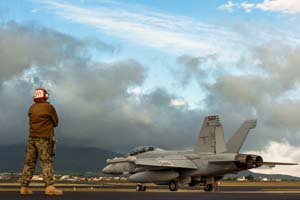
| ||
|
A Navy EA-18G Growler from VAQ-135 (Electronic Attack Squadron 135), NAS Whidbey Island, Wash., rests on the tarmac at Lajes Field in the Azores during a refueling stop. The Growler is steadily replacing the Navy’s EA-6B Prowler electronic attack aircraft, and the Air Force and Navy have agreed to continue a partnership that puts USAF electronic warfare officers in the jet with Navy pilots. (Photo by Lucas Silva) |
“We’re the only tactical [Air Force EA] game in town here,” Fischbach said in June. His squadron is the USAF element of what’s called the Joint Airborne Electronic Attack program. He’s on his second tour at Whidbey; on an earlier tour as an electronic warfare officer, or EWO, he also flew Prowlers with Navy aviators. Now, he’s more comfortable with the Navy’s unique military culture.
“I remember as a captain saying, ‘It’s not wrong, it’s just different,’ ” Fischbach said. “There are a lot of things we learn out here [that aren’t necessarily] something you get in Air Force operations.” The 390th ECS is a part of Mountain Home AFB, Idaho’s, 366th Operations Group, but its daily mission at Whidbey is to build electronic attack experts for USAF.
For EWOs, Whidbey is a sought-after billet, a chance to get in a fast jet and work the cutting edge of cracking open enemy air defenses—from locating and jamming emitters to frying communications networks and employing anti-radiation missiles.
While EWOs fly in aircraft across the Air Force, at Whidbey, a specific mindset is nurtured.
“It’s a great experience out here. … We are on the operational end of [EW]—we employ the latest and greatest,” said Capt. Ian Cunningham, a career F-15E EWO and instructor at Whidbey in the Navy’s Growler training squadron (VAQ-129). He’s been assigned there since February, teaching nascent electronic warriors the art of “turning up the noise” on enemy air defenses.
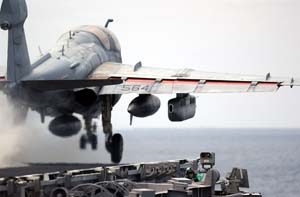
| ||
| Amn. Clay McGeshick, a bow safety observer, ducks down as an EA-6B Prowler of NAS Whidbey Island’s VAQ-129 launches from the flight deck of USS Ronald Reagan to conduct a carrier qualification sortie. Just like their Navy counterparts, Air Force EWOs get to conduct “carrier quals” during their stint with the 390th Electronic Combat Squadron as they help meet the need for electronic warfare specialists. (USN photo by Sr. Chief Photographer’s Mate Mahlon K. Miller) |
VAQ-129 is the sole EA-6B and EA-18G training squadron for the Navy and Marine Corps. USAF would call it a replacement training unit, but the Navy calls it formally a “fleet replacement squadron” or, more commonly, among aviators, RAG, for replacement air group. It is one of six electronic attack squadrons the 390th supports. EWOs operate in expeditionary squadrons at the base, known in the Navy as “concrete squadrons” because they are not attached to carriers.
Embedding
Whidbey’s naval character is evident every time a Prowler or Growler makes an approach and slams down on the runway. Naval aviation revolves around carriers, and pilots make day or night “bounces”—short, violent landings—whether or not they’re actually landing on a flattop at sea.
“It takes getting used to, for sure,” Cunningham said of landing Growlers instead of F-15Es at Mountain Home AFB, Idaho.
In the midst of this unique exchange arrangement, USAF has maintained its own culture of electronic attack since divesting its own escort and standoff EA assets in the 1990s.
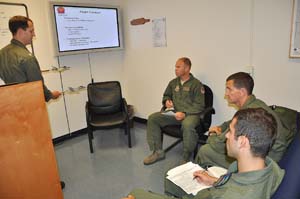
| ||
|
L-r: Navy Lt. Nicholas George briefs USAF Lt. Col. Karl Fischbach, 390th Electronic Combat Squadron commander, USAF Capt. Ian Cunningham, and Navy Lt. j.g. Justin Brown before a sortie from Whidbey Island. |
For years, Air Force electronic attack meant dedicated EW aircraft flying escort for large strike packages. These aircraft would crack open bristling networks of search-and-track radars, surface-to-air missiles, and anti-aircraft artillery batteries, collectively known as integrated air defenses. In the Air Force, this capability reached its zenith during the 1991 Gulf War.
As EW capabilities migrated piecemeal to other platforms, however—and as USAF’s plans relied increasingly on stealth—the service in the late 1990s gave up its dedicated EA jets, in the form of EF-111 Ravens. Since then, management of the escort-standoff electronic jamming mission has been ceded to the Navy, which continues to rely heavily on jamming for its nonstealthy carrier jets. Meanwhile the Air Force decided sometimes it is best to send in EW aircraft to accompany even stealthy aircraft, to give the strike packages every possible advantage.
As part of a 1995 deal brokered by the Office of the Secretary of Defense, USAF electronic warfare airmen embedded with the Navy’s EA-6B Prowlers, and now EA-18G Growlers.
In the 390th ECS the Air Force sharpens its airborne electronic attack cadre. The culture is undergoing significant change, however. The number of empty spots on Whidbey’s ramps has grown, as the Navy retires its four-seat EA-6Bs and trades up for a smaller number of new, two-seat EA-18Gs. These aircraft—F/A-18F Super Hornets permanently tricked out as escort jammers—carry the latest tools of the EA trade, including USQ-113 communication jammers, active electronically scanned array radars, wingtip receiver pods, and ALQ-99 tactical jamming pods, among other features.
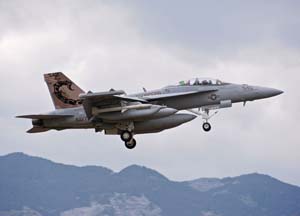
| ||
|
An EA-18G Growler of VAQ-132’s “Scorpions” on approach to Whidbey Island. USAF electronic warfare officers helped support operations during the unit’s first deployment with the Growlers in the Middle East and over Libya during Odyssey Dawn and Unified Protector. |
Whidbey’s electronic attack wing has completed about 50 percent of its transition from the Prowler to the Growler, and this affects the 390th ECS as well. Fischbach himself transitioned in late June. “Three weeks ago, I was a Prowler guy,” he noted.
As of late June, the 390th had 13 of an authorized 24 EWOs supporting six electronic attack squadrons, as the Navy draws down its four-seat Prowler force.
The Prowlers were slated to go away entirely by 2012, and in the original plan this would mark the end of USAF’s participation in the mission. However, combatant commander demand for EW has extended the Prowlers’ service lives and the need for EA-18Gs. The Navy stood up its first three EA-18G squadrons as “concrete” expeditionary squadrons and will acquire 26 more EA-18Gs than it initially planned. Now, Air Force EWOs will serve in Prowler operations until it reaches its new retirement date of 2014. Under a memorandum of understanding between USAF and Navy signed in February, Air Force EWOs will continue to embed with the Growlers indefinitely.
Getting to Domination
The electronic attack mission is getting tougher, as potential adversaries up their game by creating increasingly lethal integrated air defenses. The 390th ECS, it should be noted, is also just one part of the Air Force’s EA portfolio. The service’s EA roadmap got an Air Staff overhaul in 2010 and since then has played out under trying circumstances.
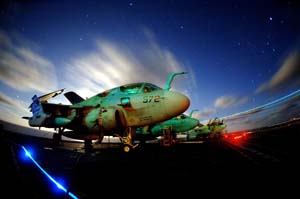
| ||
|
EA-6B Prowlers of VAQ-129 are chained to the deck onboard the carrier USS John C. Stennis off the coast of southern California. Prowlers will now retire in 2014, with Air Force EWOs continuing to fly in them. (Photo by USN Photographer’s Mate 2nd Class Mark J. Rebilas) |
“This mission is inherently fast-paced and technologically driven,” said Col. Jim Pryor, a career B-1B weapon systems officer and currently chief of EW requirements in the Air Staff’s plans and programs directorate at the Pentagon. What’s really changing is the advancement of technology, a strategy shift with greater emphasis on operating in denied and defended airspace, and an uncertain near-term budget picture, he noted.
Getting to the end state of being able to dominate the electromagnetic spectrum for the combatant commanders is “certainly not an easy task,” Pryor said.
Modernization must be planned with both rapid technological change and fiscal limits in mind. Still, “we have made a lot of progress,” said Col. Joseph Skaja, chief of the combat enabler division at Air Combat Command headquarters.
As it has gotten harder to track and counter electronic warfare, so has it been harder to find solutions in large, set-piece programs.
“With all of the advancements in technology now, there is no single system that could enable us,” Skaja said, adding that USAF’s EW portfolio must be “a system of systems.” That means pairing escort and standoff electronic attack with other pieces of the EW portfolio. Such pairings, for example, include putting the EC-130 Compass Call, and its offensive communications and counter-command and control tools, with F-16CJs, which perform the defense-suppression Wild Weasel mission of baiting and killing SAM batteries.
Fiscal Limitations
Across the spectrum, “we are going to have a standoff … escort jammer and self-protection” capability, Skaja said. “We have funded and upgraded all portions, … but with the fiscal reality we have limitations.”
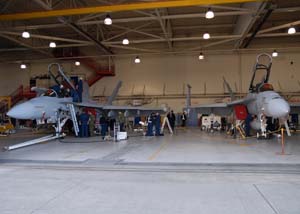
| ||
|
Sailors inspect an EA-18G Growler (left) next to an F/A-18F Super Hornet at Whidbey. (USN photo by Mass. Comm. Spec. 2nd Class Tucker M. Yates) |
A big piece of the puzzle is modernizing self-protection tools for tactical fighters, Skaja noted. The Air Force must bridge the gap between the legacy fleet and the future force dominated by F-22s and F-35s, both having comprehensive and complementary electronic attack suites.
USAF will upgrade its legacy fleet self-protection systems in the coming years. These range from onboard electronic countermeasures to ALQ-131 electronic countermeasures pods, employed on the A-10, F-16, and C-130. Air Combat Command has set aside roughly $250 million for the upgrade, and the first improved pods will arrive in 2013.
In addition to jamming pods, the Miniature Air Launched Decoy and MALD-Jammer (MALD-J) are undergoing development and testing efforts, with the goal of upgrading USAF’s F-16 fleet and its EW capabilities. MALD is an expendable air launched weapon that fools adversary radars. The jammer variant actively denies early warning radars the ability to track aircraft, using methods similar to those employed by Prowlers and Growlers.
Aside from the technical aspects, the mission of the 390th answers USAF’s need to maintain continuity of its own EW/EA culture. The squadron maintains and builds EA culture to better prepare airmen for carrying out effective electronic attack missions, both in Air Force and joint assignments.
Lt. Col. Don Keen, 390th ECS director of operations, said the transition from an EWO job on a B-52, EC-130, or even EA-6B to the tandem EA-18G can be challenging. Two-man crews face greater demands, he said, as they balance tasks ranging from helping the pilot navigate, communicate, work the radar, and manage signals analysis.
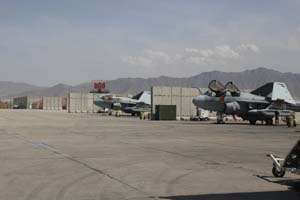
| ||
|
Marine Prowlers are seen in revetments at Afghanistan’s Bagram Airfield. (Staff photo by John A. Tirpak) |
EWOs face another transition. For nearly a decade, they have operated in a fairly permissive combat environment, free of a modern integrated air defense system (IADS). If the last decade has asked the military’s electronic attack warriors to adapt to the amorphous and blurry world of irregular warfare in the skies over Iraq and Afghanistan, the task for the future becomes even more complicated.
Air Force and Navy EWOs were front and center in last year’s operations over Libya, where electronic attack proved critical to the success of dismantling Libyan air defenses—but presented a contrast in operating environments.
Maj. Jeff Kassebaum, a former 390th ECS exchange EWO and currently chief of EW integration at USAF’s Weapons School at Nellis AFB, Nev., said operations in permissive environments have led to some complacency. Traditional doctrines needed to be updated to deal with flexible “nontraditional” IADS, such as those experienced in Libya.
Muammar Qaddafi’s forces, Kassebaum noted, could find, fix, track, target, engage, and assess due to a number of factors, but especially due to its ability to tap civilian infrastructure such as the air control radar at Tripoli Airport.
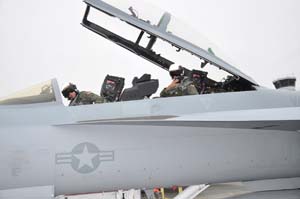
|
|
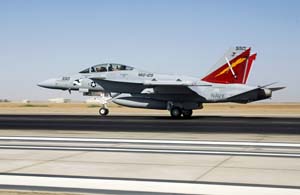 |
|
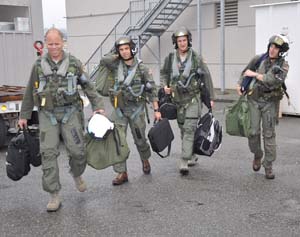 |
|
|
Top: Navy EA-18G pilot Brown and Air Force EWO Cunningham ready for a training sortie. Middle: An EA-18G takes off from NAS El Centro, Calif. (USN photo by Mass Comm. Spec. 3rd Class Rialyn Rodrigo) Bottom (l-r): Fischbach, Brown, Cunningham, and George head to the Whidbey flight line for a morning Growler sortie. Air Force EWOs assigned to Whidbey work in tandem with Naval aviators every day to sharpen and refine core electronic attack skills. |
“Suppressing an IADS must not rely on doctrine focused only on military infrastructure,” Kassebaum asserted, adding that “suppression is more than employing anti-radiation missiles.” Writing in the Journal of Electronic Defense in December 2011, Kassebaum, who served as chief of the Suppression of Enemy Air Defenses cell during Operation Unified Protector, wrote, “We deceive ourselves if we assume tomorrow’s threat IADS will look anything like past IADS.”
The profile of EA is rising, due in large part to proliferation of electronic systems for both attack and defense. In fact, the new catchphrase in combatant commander requirements documents is their need to operate in a “contested EMS” or electromagnetic spectrum. The growing lethality of worldwide anti-access and area-denial capabilities likewise raises the prominence of EA.
“I don’t know how to scale that, but I think there are more people who are looking at [EA] and it is generating a lot of conversation,” said Pryor. “Across the joint spectrum it is gaining importance. … The whole force has to operate in this domain,” he said.
Squeezing the Nickel
Electronic warfare is an inherently expensive enterprise, however, and the Pentagon is tightening its belt severely. A keystone Air Force program to expand its EA capabilities, the B-52 Stand-Off Jammer, was killed off twice in the last decade due to “requirements creep” and ballooning cost. While ACC planners felt the SOJ was critically needed at the time, demands on the fleet and requirements have shifted.
Now, USAF plans to concentrate on the assets already in hand to get the most out of its EW dollars and fulfill its slice of the EW mission. No one expects reinstatement of the SOJ or anything like it in the near future.
“Threats are changing, and we need to challenge our core concept of electronic warfare overall,” Pryor said.
Key to this effort is maintaining the health of programs such as the agreement between the Navy and Air Force for joint manning. Air Staff and ACC officials tout the exchange program with the Navy as a great success story, and say the program stands now on “solid ground” going forward.
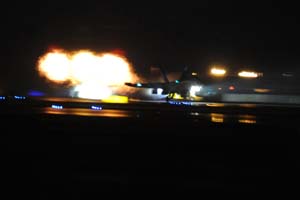
| ||
|
A Growler takes off from Aviano AB, Italy, on March 20, 2011. Electronic attack against Libyan air defenses was a critical capability during Operation Odyssey Dawn and Operation Unified Protector last spring. USAF photo by SSgt. Nadine Y. Barclay) |
As the Air Force continues to embed airmen on new Navy Growlers, another exchange in the works could see Marine Corps EA-6B aircrew swap seats with counterparts on Air Force EC-130 Compass Call aircraft. An ACC spokesperson said the benefits of the agreement would include cross-tactic coordination, a further expansion of joint EW operations, and building awareness of shared responsibilities during EA operations.
In the late 1990s, as the Air Force determined its future lay in an all-stealth fighter force, a certain school of thought held that stealth would largely solve the problem of escort and standoff electronic attack. Today, however, that view is hard to come by. In fact, when asked about the future of USAF electronic attack culture in the absence of a service-owned flying mission, the USAF officers at Whidbey were bullish. EA, they said, is here to stay.
“Our guys have moved on to staff billets,” and leadership positions, Fischbach pointed out. The breadth of experience at Whidbey gives EWOs training that offers a unique perspective. “We’re building the guys … who are going to be in the Air Force for 20 more years. They will carry that EW culture back with them” to their squadrons, to ACC, or to the Air Staff.
It is incumbent on the Air Force to make sure the service retains this valuable perspective—as it looks to the future of working with the EA mission in a joint environment. “At the end of the day, the Navy doesn’t really care if the Air Force understands electronic warfare,” Keen said bluntly. “They have their own mission to worry about. It’s up to us.”
| Widening the EW Perspective
Air Force Lt. Col. Don Keen, director of operations for the 390th Electronic Combat Squadron here, spends a lot of time on temporary duty assignments. A career F-15E backseater, he recently briefed a commander’s conference at Osan AB, South Korea, on electronic warfare. This is all part of the squadron’s mission, he says: preserving the electronic attack mindset in the Air Force and taking that perspective into future assignments.
Officials at this Air Force squadron, at a Navy facility, run into just as much of a culture shock when they head out to USAF installations. Officers joke they are frequently called on to use their “decoder rings” to help airmen understand all things EA. “We are here to learn, and to share our experience when we leave,” Keen notes—and that means looking at EA strategically and not just from the perspective of self-protection. He recalled one assignment where he was sent to a conference to discuss the Miniature Air Launched Decoy program, and everyone who spoke came at the problem from a self-protection point of view, rather than looking at EA as a battlespace effect. “I think I was the only EW guy in the room,” he said. The 390th ECS is a key component of a USAF-wide drive to reinvigorate EW culture across the service and increase manpower in this sensitive mission set. The unit has a unique role, says Lt. Col. Karl Fischbach, the squadron’s commander. “As far as EWO development, you’re maintaining a cadre of spectrum dominance experts.” Flying with the Navy affords a different perspective on electronic attack, emphasizing jamming. The Air Force, meanwhile, must look holistically at the battlespace and ensure the safety of an entire air campaign. The Air Force is charged with rolling back an integrated air defense system in any given strike package, Fischbach notes, and that requires a tailored use of skills, from dealing with detection radars all the way up to defeating SAM batteries. “All those operate in the [electromagnetic] spectrum— … We operate in the lower end of that spectrum,” he says. Navy and Air Force EWOs attack and outsmart early warning, detection, and acquisition radars—the prime targets of standoff and stand-in jamming. While suppressing radars and SAM sites is a part of the mission, EA looks at the problem from a bit higher up, Fischbach and the squadron EWOs say. “Fighter pilots—if you ask what [EW] is doing—they say, ‘Oh yeah, it’s my pods,’ ” Fischbach explains. “They’re looking at the end game.” For the EWOs, however, it is about generating an effect that can apply across the combat zone. This ensures, as Fischbach put it, that SAMs are kept “on the rail.” |